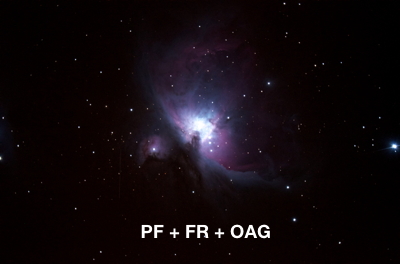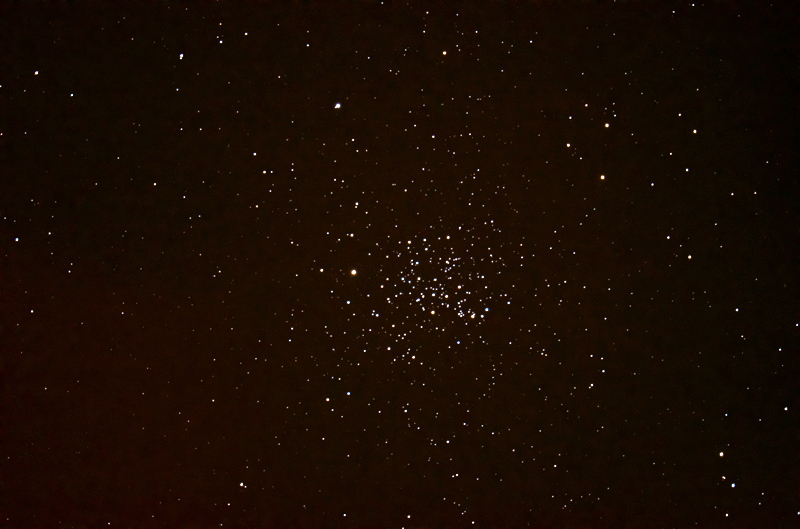Uranus Moons, Extension Tube Tests, Monkey Head Nebula,
Messier Star Clusters, Comet Lovejoy
Posted: 18 January 2015
|
Open: Saturday, 17 January 2015, 1802 MST Temperature: 68°F |
Session: 770 Conditions: Mostly clear, clouds W-NE |
1809 MST: viewed Mercury, 83X. Half phase visible. Venus, 83X. Slight gibbous phase visible.
1814 MST: viewed Uranus, 83X and 222X. Began preparing D7000 DSLR for prime focus imaging of Uranus and hopefully some of its moons to confirm that I did capture two moons on the previous session.
Comet C/2014 Q2 (Lovejoy) visible to naked eye 25 minutes before the end of Astronomical Twilight. 1853 MST: the Zodiacal Light was visible.
While viewing Uranus at 222X, I seemed to be able to detect a moon closer to the planet than one that was seen on the previous session. 1906 MST: did a 20 seconds, ISO 6400, exposure at prime focus of the f/10 8" telescope. This highly magnified crop of the full-frame image shows three moons:

Using SkySafari Pro for Mac OS X, I was able to determine which moons that I captured.
The follow image shows two moons as they were 24 hours previously. Mouseover (or tap) the image to view an animation centered on Uranus showing these moons changing position, as well as Uranus moving against the background stars.

Mouseover or tap on image
I then began some equipment tests. When I added the JMI MicroFocus Dual-Speed Telescope Focus Knob to my 8" LX200-ACF focus knob I found that I could no longer orient my D7000 DSLR on my off-axis guider (OAG) as I had previously (photo showing previous configuration). I had to rotate the camera/OAG combination about 90° to have the camera clear the new focus knob and put the reticle eyepiece in a convenient position. I began to wonder if adding an extension tube would help by moving the camera further backward away from the end of the telescope (and focus knob). But I didn't have an extension, or so I initially thought. I finally remembered that I had removed an extension tube from the visual back that was part of the Meade 2" star diagonal. I had placed the extension tube in an accessory drawer in the observatory and had forgotten about it after I started using the diagonal almost two years ago. I decided to try some tests with and without the extension tube on the OAG.
This is the DSLR with the OAG directly connected to the SCT port at the rear of the telescope, showing how the JMI focus knob touches the camera:

Here the extension tube has been added to the OAG, although there is still some slight interference with the focus knob in a few orientations:

This photo has just the focal reducer with the OAG, showing some clearance issue:

And lastly, the focal reducer + extension tube + OAG, showing that there is no clearance issus at all:

I did some 30 seconds, ISO 1600, exposures of M42 (Orion Nebula) to check that I was able to focus while using the extension tube and to determine how much change there was in the imaged field-of-view (FOV):




Only a very slight FOV reduction is evident while using the extension tube. Therefore I now plan to use the extension whenever I am using the off-axis guider for imaging. Glad I remembered I had this extension tube!
Leaving the focal reducer and extension tube connected, I slewed to NGC2174 (Monkey Head Nebula) and found a faint guide star. This is a 5 minute, ISO 6400, guided exposure:

Tracking was very good this night and only minimal infrequent manual corrections were needed.
Next, I did some more Messier Catalog object imaging for my Messier Photo Album. Open star clusters were imaged this night, prime focus + focal reducer + extension tube + OAG, with 30 seconds, ISO 1600, exposures:
M47

M48

M50

M67

M93

2122 MST: thin clouds were now in the southwest and north sky. Slewed to Comet Lovejoy and did some 1 minute, ISO 5000, exposures. Unfortunately, those short exposures at prime focus + focal reducer + extension tube + OAG did not bring out the faint tail as well as I hoped. This exposure (slightly cropped), 5 minutes, ISO 5000, does show the very faint tail (the comet's head is overexposed):

2149 MST: ended imaging and removed the camera and accessories.
2201 MST: viewed Jupiter, 83X, through thin clouds. The four Galilean Moons were nicely spread out in a line. Thin clouds were now in most of the sky.
|
Close: Saturday, 17 January 2015, 2217 MST Temperature: 52°F |
|
Comments are welcome using Email. If you are on Twitter you can use the button below to tweet this report to your followers. Thanks.
Cassiopeia Observatory Home Page
Copyright ©2015 Michael L. Weasner / mweasner@me.com
URL = http://www.weasner.com/co/Reports/2015/01/18/index.html
